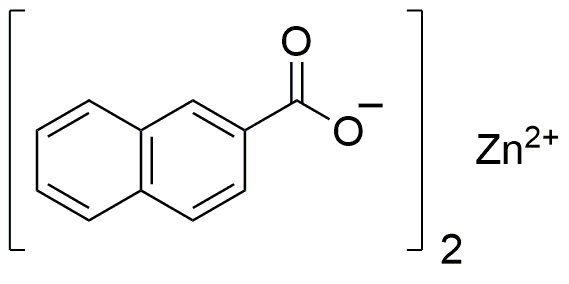Zinc naphthenate is widely utilized in research focused on various applications across multiple industries. Here are five practical uses:
- Wood Preservation: This compound is commonly used as a wood preservative, protecting against fungi and insects. Its effectiveness in extending the lifespan of wooden structures makes it a popular choice in construction and furniture manufacturing.
- Coatings and Paints: Zinc naphthenate serves as a drying agent in paints and coatings, enhancing their performance. It helps improve the drying time and durability of the final product, making it valuable in the automotive and industrial coatings sectors.
- Agriculture: In agriculture, it acts as a micronutrient source, particularly for crops that require zinc for optimal growth. This application supports healthier plants and can lead to increased yields, benefiting farmers and agricultural producers.
- Rubber Industry: The compound is used as an accelerator in rubber production, improving the vulcanization process. This results in stronger and more resilient rubber products, which are essential in automotive and industrial applications.
- Corrosion Inhibition: Zinc naphthenate is effective in preventing corrosion in metal surfaces, making it useful in various industrial applications, including marine and oil industries. Its ability to protect metal components enhances their longevity and reduces maintenance costs.
General Information
Properties
Safety and Regulations
Applications
Zinc naphthenate is widely utilized in research focused on various applications across multiple industries. Here are five practical uses:
- Wood Preservation: This compound is commonly used as a wood preservative, protecting against fungi and insects. Its effectiveness in extending the lifespan of wooden structures makes it a popular choice in construction and furniture manufacturing.
- Coatings and Paints: Zinc naphthenate serves as a drying agent in paints and coatings, enhancing their performance. It helps improve the drying time and durability of the final product, making it valuable in the automotive and industrial coatings sectors.
- Agriculture: In agriculture, it acts as a micronutrient source, particularly for crops that require zinc for optimal growth. This application supports healthier plants and can lead to increased yields, benefiting farmers and agricultural producers.
- Rubber Industry: The compound is used as an accelerator in rubber production, improving the vulcanization process. This results in stronger and more resilient rubber products, which are essential in automotive and industrial applications.
- Corrosion Inhibition: Zinc naphthenate is effective in preventing corrosion in metal surfaces, making it useful in various industrial applications, including marine and oil industries. Its ability to protect metal components enhances their longevity and reduces maintenance costs.
Documents
Safety Data Sheets (SDS)
The SDS provides comprehensive safety information on handling, storage, and disposal of the product.
Product Specification (PS)
The PS provides a comprehensive breakdown of the product’s properties, including chemical composition, physical state, purity, and storage requirements. It also details acceptable quality ranges and the product's intended applications.
Certificates of Analysis (COA)
Search for Certificates of Analysis (COA) by entering the products Lot Number. Lot and Batch Numbers can be found on a product’s label following the words ‘Lot’ or ‘Batch’.
*Catalog Number
*Lot Number
Certificates Of Origin (COO)
This COO confirms the country where the product was manufactured, and also details the materials and components used in it and whether it is derived from natural, synthetic, or other specific sources. This certificate may be required for customs, trade, and regulatory compliance.
*Catalog Number
*Lot Number
Safety Data Sheets (SDS)
The SDS provides comprehensive safety information on handling, storage, and disposal of the product.
DownloadProduct Specification (PS)
The PS provides a comprehensive breakdown of the product’s properties, including chemical composition, physical state, purity, and storage requirements. It also details acceptable quality ranges and the product's intended applications.
DownloadCertificates of Analysis (COA)
Search for Certificates of Analysis (COA) by entering the products Lot Number. Lot and Batch Numbers can be found on a product’s label following the words ‘Lot’ or ‘Batch’.
*Catalog Number
*Lot Number
Certificates Of Origin (COO)
This COO confirms the country where the product was manufactured, and also details the materials and components used in it and whether it is derived from natural, synthetic, or other specific sources. This certificate may be required for customs, trade, and regulatory compliance.


